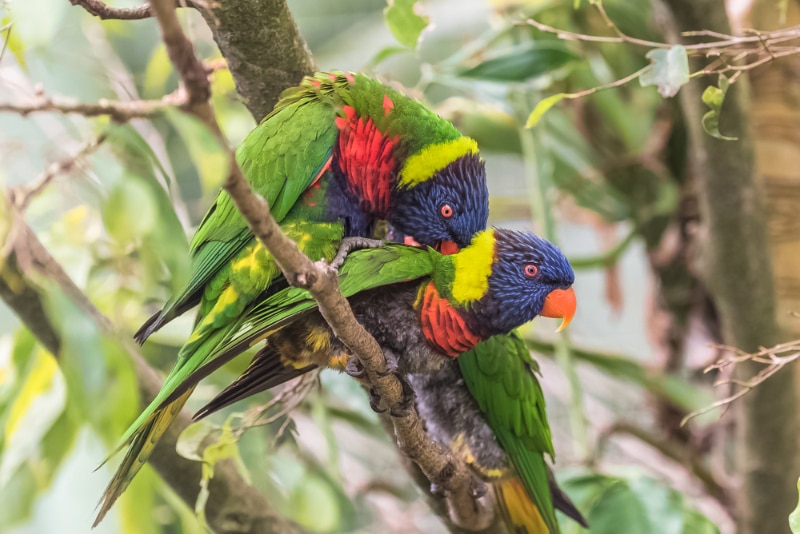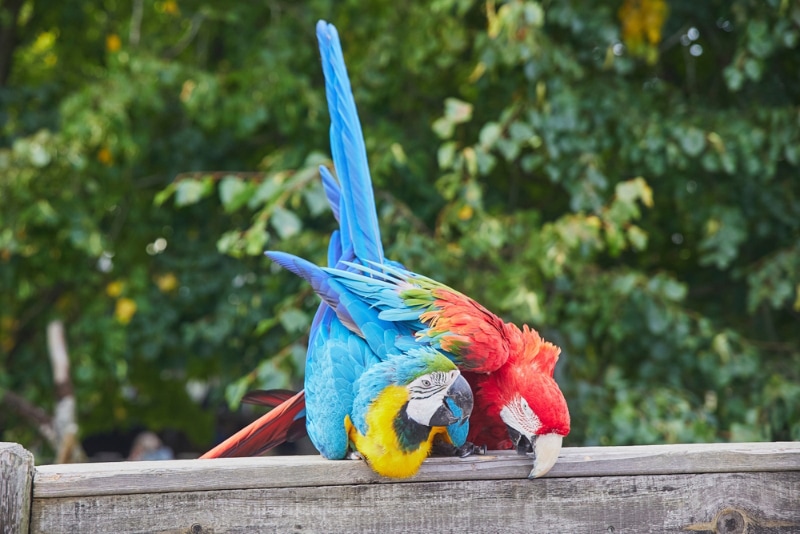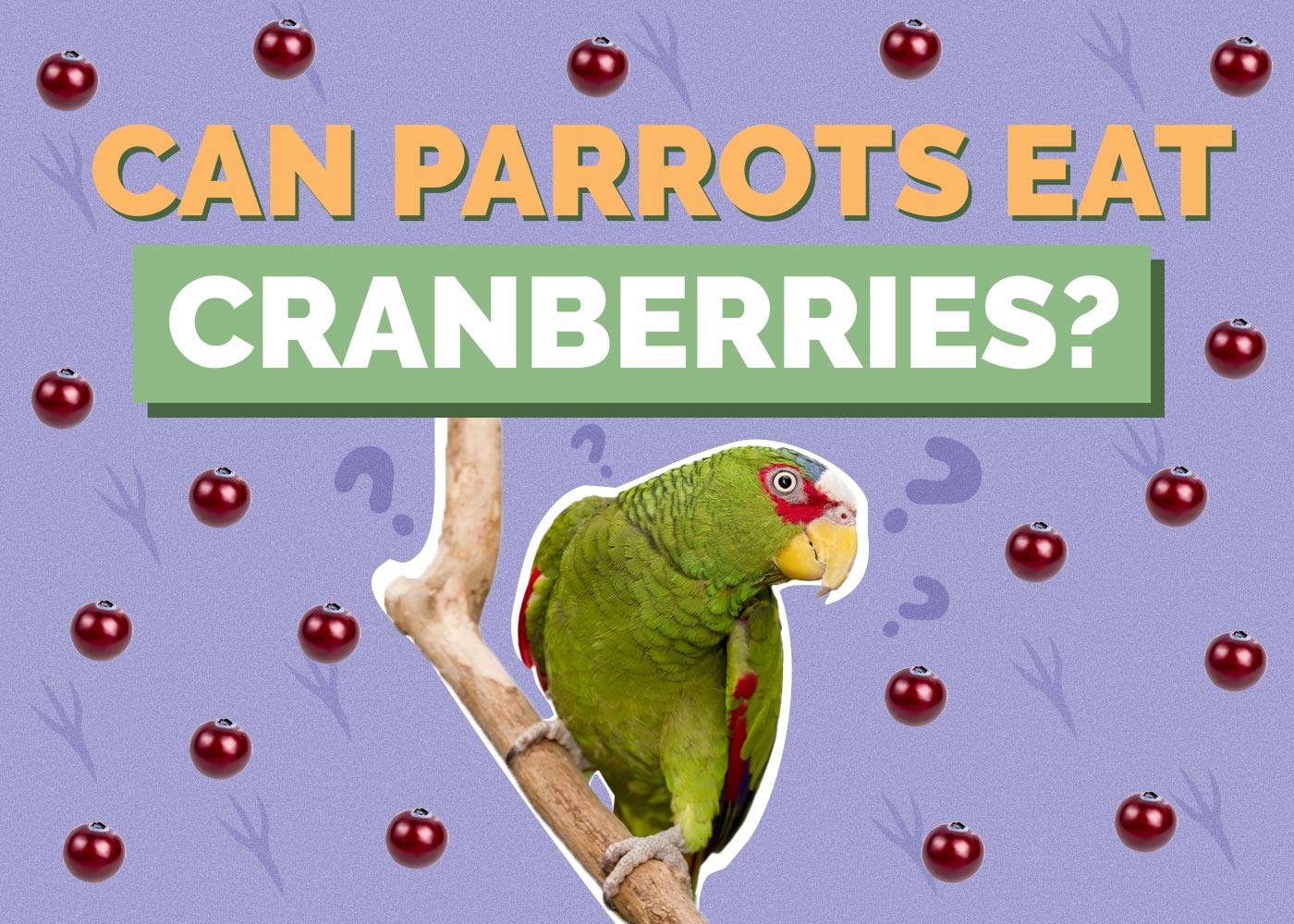How Do Parrots Mate? Vet-Approved Reproduction Explanation
Updated on

Click to Skip Ahead
Disclaimer: Parrots are a broad order of birds, consisting of approximately 350 species from the typical “pirate shoulder” macaws, to much smaller lovebirds and cockatoos. In this article we will be focusing on the parrots in general, and there are likely some species exceptions to these general rules.
Parrots can be downright romantic when they want to be, and their mating practices are often highly colorful, noisy and competitive! They have some very interesting ideas on what constitutes flirting and attraction. They’re mostly monogamous like us, meaning they bond with a single mate. Sometimes that’s for life, and other times it’s not. Again, much like us humans.
Parrots have different genitalia to mammals, most strikingly, the male parrot doesn’t have a penis. Instead, both the male and female parrot have a small opening called a cloaca, which is where the magic happens. To mate, parrots will align their cloacas, and the male will eject sperm into the female’s cloaca, where it moves into specialized storage tubes before fertilizing the female’s eggs a little later on. The cloaca is a common passageway for feces, urine, urates, eggs (in the female) and sperm (in the male) and is merely a collecting and storage compartment during mating.
If you’re wondering about what their mating practices are like or how the parrot mating season works, you’re in the right place. Let’s check out some of the most interesting info related to parrot mating.
Do Parrots Mate for Life?
It’s a common misconception that parrots mate for life, but that’s not strictly the case. Parrots are usually monogamous, and this monogamy usually extends to all mating seasons and during the rearing of offspring. The reason for this is that rearing eggs to independent birds is a difficult task and it takes both members of the pair to make this successful. In captivity, parrots often mate for life when confined with a parrot of the opposite sex. Mated pairs of parrots in the wild are commonly seen staying and traveling together long after mating season, but it depends on the species and the individual birds. Birds may not exactly fall in love the way humans do, but they do seem to grow accustomed to having a single partner. However, if one of the pair passes away or is not reproducing successfully, the other member of the pair will often find a new mate.

When Is the Parrot Mating Season?
Most parrots mate at the beginning of spring or warmer months of their habitat, but some mate during the wetter months too. Mating season brings a host of hormonal changes in a parrot, manifesting in more outwardly social or even aggressive behavior. Many parrot owners have been alarmed when their mature parrot starts biting or “bluffing,” but it’s actually normal and indicative they want to mate.
On a chemical level, changes of day length, exposure to sunshine and an increased abundance of food are thought to trigger a bird’s mating season. For example, when the days start getting longer during early spring, many parrots may become territorial and defensive, start building nests, or even exhibit masturbatory behavior. Depending on their species, unique mating rituals like tail fanning, wing flapping, or regurgitation are common among parrots.
Signs of Mating Behavior in Parrots
Parrots are shockingly frisky creatures, despite their monogamous habits. Every year (sometimes twice yearly) during their breeding season/s, parrots receiving more sunlight than usual will enter mating mode and search for mates, displaying some very forward behavior to attract one. Let’s examine some common mating behaviors you might see in a wild or captive parrot during mating season.
- Territorial behavior: Parrots will become more protective of their nest, cage, food, and even toys during their mating season.
- Biting: Also called bluffing, biting is one of the most common signs your parrot is looking for a mate.
- Vocal calls: Even reticent parrots will become screechy during their mating season, and it’s one of the most obvious signs people usually notice first.
- Mating rituals: From fanning their tail feathers to strutting dances, exact mating rituals vary by parrot species.
- Regurgitation: Parrots in their mating season often regurgitate their food as a charming “present,” whether to you or a prospective mate.
The 6 Tips for Preventing Hormonal Behavior in Parrots
Parrot owners reading this might recognize a lot of these signs in their own birds, but first and foremost they’re probably wondering how to stop the showy, screechy demon their parrot seems to have transformed into. The good news is that you can artificially limit mating behavior from developing in your tame parrot – let’s check out how right below.
- Limit light levels: Parrots should receive a max of 12 hours of light, and should receive 12 hours of total darkness to sleep and roost. Any more than 12 hours of light can trigger hormonal mating behaviors.
- Food intake: Limit your parrots intake of high calorie, high fat and simple carbohydrate foods. Foods such as these will trigger the increased production of hormones related to reproduction.
- Keep the cage clean: Frequently cleaning and rearranging your parrot’s cage will help prevent them from choosing spots to lay eggs. They prefer spots that haven’t been touched in a while.
- Avoid “sexual” touches: Specifically, this is why you shouldn’t pet your parrot’s back or tail feathers, as it stimulates sexual behavior. Stick to petting only your bird’s head and feet.
- Remove “loveys”: Sometimes parrots can appear to bond with a favored toy and exhibit mating behavior. Remove these toys to discourage them. Remove mirrors, as birds that are kept alone may try and bond with their reflection.
- Adhere to a strict bedtime: Lengthening the day too much can kickstart mating hormones, so make sure your parrot gets a strict 12-on, 12-off schedule.

Wrapping Up
Parrots don’t have sex in the way mammals do, but they do tend to prefer monogamous relationships that we can relate to. Most parrots mate in the springtime, showing a wide range of easily identified hormonal behaviors in their quest for a suitable partner. For captive birds, this behavior can be artificially mitigated by reducing light levels and discouraging hormonal behavior.
See Also:
Featured Image Credit: Pascale Gueret, Shutterstock











